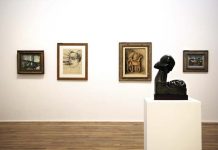A striking feature of David Magila’s work, simultaneity seems to have an effect on his calendar as well. With three exhibitions inaugurating one after the other in the month of May 2019, the artist makes a striking entrance into São Paulo’s scene. They are three different spaces and with different vocations, in which it exposes a wide range of works, almost all of them unpublished, which together make up a very comprehensive panorama of the main issues that motivate it.
“It was a result of chance”, he explains, emphasizing that each of these shows has its own history, but without denying the existence of important links between the different expository hubs. The first of these projects happened in the garden of the mansion occupied by the Ema Klabin Foundation. It was conceived in the context of the Festival Labas, an initiative of the Lithuanian community in São Paulo, and led the artist to immerse himself in the history of his family, in the affective and symbolic memory linked to the locksmith’s place ran by his grandfather, who took refuge in Brazil in the 1930s, and where he learned the craft by welding bins.
The second show, which opened at the British Cultural Center, was marked by a dialogue with the British artist Hurvin Anderson. It encompasses not only paintings – language that the artist has been exploring more hard in recent times – but also sculptures, drawings and videos. Recent works of his own have also been exhibited in individual exhibitions at Galeria Janaina Torres. These last two hubs of works reveal, by means of a subtle yet intense dialogue, the at once fluid and coherent character of his poetics.
In Magila’s works there always seems to be a farther, more remote, starting point than the first appearances indicate. His painting, despite the ethereal character, is not an invented construction. The inanimate objects and scenes that emanate these constructions always derive from scenes of reality, which the artist collects as an explorer, usually in decadent and abandoned places, and recorded by photographs or drawings of observation.
This careful record of landscapes and details is part of your process. Graduated in arts by Unesp in the early 2000s and often as one of the highlights of the young Brazilian painting, Magila has a very diversified trajectory, marked by moments of exclusive dedication to graphic design and the search for an association between different forms of expression artistic
Empty chairs, debris from bars, umbrellas not only populate his screens creating a somewhat nostalgic scene, but also serve as a structure for the entire composition. “I do not paint the object, I paint around it”, he explains. The empty architecture, the deserted environments are their theme. They never see human traces in them, but we know they’ve been there. Magila confesses interest for places that have the mark of a certain experience, places that feed a series of works. This is the case, for example, of a beach in Iguape, which is being eaten by the sea and which is the source of several of the works shown in the British Center. In several visits to the site he collected not only scenes, but objects engulfed by the sea (any relation to an impulse of ecological denunciation would not be mere coincidence), later transforming these spoils into a large facility.
Despite the chromatic power of the screens, it is always from the drawing that the image is structured, in a series of re-readings to the final form. The mixture of techniques, the influence of his formations in technical drawing (by the Lyceum of Arts and Crafts) and the experience as graphic artist – area in which he worked for a long time – leave their marks in the work. And they contribute to create this feeling of a composition that does not necessarily seek a definitive harmony, but rather to promote the coexistence, somewhat ambiguous, of elements only seemingly disparate. His paintings seduce and defy the senses at the same time.











